Hello, fellow GRC enthusiasts! As we wrap up another quarter, I’m thrilled to share the latest updates and enhancements we’ve made at ZenGRC. These new features are not just incremental improvements; they are transformative tools and revolutionized workflows that enable organizations to tackle GRC challenges like a pro.
